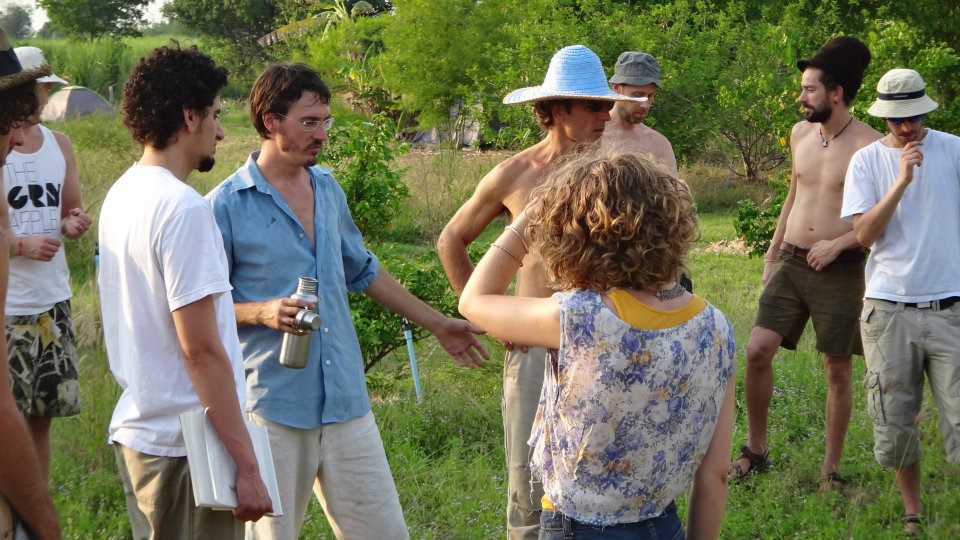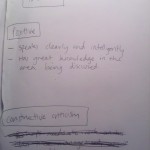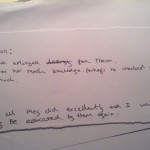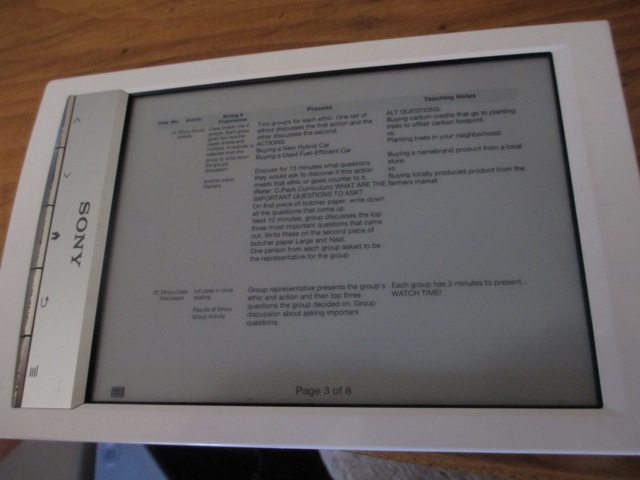Designing all the elements of a Permaculture Design Course, I’ve learned, is no small task. It’s much more than just standing up in front of a classroom full of folks and talking about soils, trees and earthworks. It’s even more than just designing 72 hours worth of curriculum. There are so many other elements it almost becomes more challenging to insure that everything comes together into one cohesive course than it is to know what to say and do when it happens.
Early Outline & Schedule
Early on I recognized the need to exercise one of the core principles of permaculture and ‘design from patterns to details’. I created a rough outline to capture the broader pattern of the course schedule with room to drill down into some of the finer details.
As you can see, my original outline was never finished. Drafting this outline served as an initial rough guide that allowed me to think about all the various sessions I had to work with and how to arrange the lessons into a pattern that flowed well. This patterning actually caused me to step back farther and look at the root structure of the schedule. I constructed a set of tables to help me visualize the schedule format in a various ways.
|
Day |
Saturday |
Sunday |
Monday |
Tuesday |
Wednesday |
Thursday |
Friday |
|
Week one (Aug 18th – 24th) |
7:30 AM – 6:00 PM |
7:30 AM – 6:00 PM |
7:30 AM – 6:00 PM (Optional) 7:30 – 9PM |
7:30 AM – 6:00 PM |
7:30 AM – 6:00 PM (Optional) 7:30 – 9PM |
7:30 AM – 6:00 PM |
DAY OFF |
|
Week two (Aug 25th – 31st) |
7:30 AM – 6:00 PM (Optional) 7:30 – 9PM |
7:30 AM – 6:00 PM |
7:30 AM – 6:00 PM (Optional) 7:30 – 9PM |
7:30 AM – 6:00 PM |
7:30 AM – 6:00 PM (Optional) 7:30 – 9PM |
7:30 AM – 6:00 PM |
GRADUATION PARTY (Starts at noon) |
|
Session |
Time |
Minutes |
|
Breakfast |
7:30 – 8:00 AM |
30 |
|
Hands-on Farm Choirs |
8:00 – 9:00 AM |
60 |
|
Review |
9:00 – 9:30 AM |
30 |
|
A |
9:30 – 11:00 AM |
90 |
|
Break |
11:00 – 11:30 AM |
30 |
|
B |
11:30 – 1:00 PM |
90 |
|
Lunch |
1:00 – 2:30 PM |
90 |
|
C |
2:30 – 4:00 PM |
90 |
|
Break |
4:00 – 4:30 PM |
30 |
|
D |
4:30 – 6:00 PM |
90 |
|
Evening Activity |
7:30 – 9:00 PM |
(OPTIONAL) 90 |
During this period of the design phase there was a significant amount of feedback looping between analysis and design. I was pushing ahead with designing elements while receiving feedback from various mentors, teachers and peers as well as the course hosts.
To support this process, I used what I learned from Geoff Lawton’s PDC Teacher Training course and began constructing a curriculum that was rooted in Bill Mollison’s Permaculture: A Designers Manual. In addition, I sought out other PDC teacher’s course outlines and notes. A valuable resource for this turned out to be the Worldwide Permaculture Network. PRI recognized teachers post their course outlines as a requirement for recognition. Downloading and digesting these course outlines allowed me to gain a diversity of perspectives on how experienced teachers were designing their Permaculture Design Courses.
As mentioned in the previous section, Goals and Analysis, the course schedule was modified soon after discovering that the host family had a baby on the way. Expected at the same time as I had originally penned in for the course, a new life takes priority over any other attempts at scheduling. There was nothing else to do but apply yet another core design principle and ‘creatively adapt and respond to change’. Fortunately, this information came to light early on, before the major advertising push, and altering the schedule was relatively painless.
Advertising & Booking
As I mentioned in previous sections of this project, I wrote this article as somewhat of an initial teaser advertisement for the course. I wanted to create a bit of a buzz and the article was phenomenally successful toward that end. To this date, my blog has yet to receive a single day of web traffic greater than the day this article was posted.
As the conversation developed, the narrative and timing became more clear and I began working on the booking form and flyer.
Event booking
Through my experience learning from Christian Shearer, I was introduced to Eventbrite, an event booking website that makes creating event registration easy at a nominal cost. I went to work exploring the platform and loading in the course details. Learning from the PDC that we were preparing to host at the project site in Thailand, I was able to build a course listing through Eventbrite without having to start completely from scratch. Below I provide links to the various elements developed within the booking process.
Aug PDC Eventbrite Booking Form
Aug PDC Eventbrite Management Page
Aug PDC Eventbrite Order Confirmation
Event Flyers
While I was developing the booking and registration process, I was also working on course advertisement. As I mentioned before, there were serious challenges to being on the other side of the world while trying to promote a course. My strategy for managing this challenge was to offer the course to a select couple of people in exchange for their help in promoting it. Because my goals financially where to break even and distribute any additional profit amongst local organizations I had a little bit of leeway in offering the course on barter.
It’s difficult to say how effective the flyers were or whether they even got out to that many people. Regardless, I feel it was worthwhile to make and have distributed. Creation Flame, as the course hosts, also distributed their own flyers. These flyers were likely a bit more effective as they went straight to the hands of people involved with Creation Flame and likely hearing about the course through other means.
Web trafic & social media
Aside from the direct marketing, there was a large push through social media sites and through this website. Below is the results of hits and ticket sales through Eventbrite:
| EVENTBRITE PROMOTION SOURCE | VISITS | TICKETS SOLD | SALES |
| Facebook Connect | 35 | 0 | $0.00 |
| Eventbrite Monthly Newsletter | 1 | 0 | $0.00 |
| Eventbrite Button | 0 | 0 | $0.00 |
| Evenbrite Countdown Widget | 72 | 0 | $0.00 |
| Facebook Event Link | 45 | 2 | $100.00 |
| Facebook News Feed From Liking Event | 319 | 1 | $50.00 |
| Facebook Newsfeed Event Name Link | 3 | 0 | $0.00 |
| Invite Friend Link | 1 | 0 | $0.00 |
| Eventbrite Invitation | 34 | 0 | $0.00 |
| Eventbrite Organizer Pages | 4 | 0 | $0.00 |
| Eventbrite Organizer Page Featured Event | 12 | 0 | $0.00 |
| Eventbrite Search Placement | 254 | 1 | $50.00 |
| Facebook Share Link | 3 | 0 | $0.00 |
| Linked In Share Link | 33 | 0 | $0.00 |
| Ticket Widget | 0 | 0 | $0.00 |
| Eventbrite Website Integration | 2 | 0 | $0.00 |
| Eventbrite RSS Feeds | 3 | 0 | $0.00 |
| TOTAL | 821 | 4 | $200.00 |
Of all the visited pages on this site, the PDC listing is ranked at number 3, beaten only by the new landing page and the main blog page:
| Title | Views | |
|---|---|---|
| Home page / Archives | 2,146 | |
| Pioneers Welcome! | 569 | |
| August PDC in Austin, Texas!! | 255 |
Financial Design
When designing the course I worked out a basic financial plan. Like any good design I considered my goals before proceeding. Financially, my goals were to pay for my travels, offer the PDC to friends who had supported me, give back to the community and various organizations that were doing good work and break even on the whole thing. Being that this was my first course, I also didn’t want to over price it. Other Permaculture Design Courses in the area are around $550-$600. I wanted to price this course cheaper for my own comfort as a new teacher as well as to be competitive with other courses that had a much more established history.
Basic Financial Design
Again using the “Patterns to Details” design principle I totaled up what I thought the expenses might be. Flight cost, materials, host payment and a nice sized overrun to cover any unexpected expenses. Then I worked out how many students I would need at several different price ranges to cover expenses. From this, I settled on $525 total course cost with a maximum of 30 attendees. With these numbers, I could offer up to 10 full sponsorships, 5 half sponsorships with 15 attendees at full price and still have an overrun of around $3000.
Here is an early spreadsheet of the financial design:
|
Full Price
|
Discounted
|
Free
|
Expenses
|
Return
|
Attendance
|
|
521.26
|
250
|
0
|
1705.70
|
||
|
521.26
|
250
|
0
|
2500
|
||
|
521.26
|
250
|
0
|
1500
|
||
|
521.26
|
250
|
0
|
|||
|
521.26
|
250
|
0
|
|||
|
521.26
|
0
|
||||
|
521.26
|
0
|
||||
|
521.26
|
0
|
||||
|
521.26
|
0
|
||||
|
521.26
|
0
|
||||
|
521.26
|
|||||
|
521.26
|
|||||
|
521.26
|
|||||
|
521.26
|
|||||
|
521.26
|
|||||
|
7,818.9
|
1250
|
0
|
5705.7
|
3363.2
|
30
|
This design allowed me some flexibility around making sure the goals were met. My main concern was not loosing money and I was confident and excited to have to opportunity to profit in other ways from the course.
Past experiences
I have been fortunate to have experience working with financial systems that proved to be a great advantage in designing this course. While working at Wheatsville Co-op I gained experience working with financial systems through Open Book Financing. The department I was managing at the time was the first department to implement Open Book Financing. With six sub-departments that cumulatively were responsible for roughly 53% of store sales, the grocery department was a critical link in developing this new management strategy. I felt very fortunate to have the opportunity to lead this drive and learn about financial systems in an interactive and fun way.
Later, during my time at Rak Tamachat in Thailand, based on my previous experience, I developed a system to manage our finances through a similar system. In my next diploma design project I will go over the details of Open Book Financing and my work to implement it into a variety of organizational models. I was also very fortunate to gain some experience working with the very same financial systems at Rak Tamachat that I would use for my own course in Austin. The complexity of working with course finances at Rak Tamachat were much greater than anything I knew I would deal with in Austin, if simply due to the many different currencies of an international education center.
Curriculum Design
The curriculum was the by far the most extensive aspect of the design. Once I had a general idea of how the schedule might lay out I started working on filling in how I wanted to teach the various elements. As usual, my past experiences would play a major role in how I designed the curriculum.
First Pdc teaching experience
I wanted to create an experience that built off all of the positive experiences I’ve had with experiential and interactive learning. I was quickly coming to realize that I didn’t enjoy, or feel comfortable in a lecture teaching format. This feeling was reenforced during my first teaching experience in a Permaculture Design Course. I was scheduled to teach the a full day on trees, forests systems and food forests after only a month at Rak Tamachat in Thailand.
Christian Shearer offered me his course notes as a teaching tool. I made only minor modifications to them and prepared myself for the long day ahead. What I didn’t realize at the time is how difficult it is to step into a course mid-stream and give a lecture based off someone else’s notes. The beginning of the day was the most challenging as I felt far too dependent on those notes. As the day went on, my nervousness dropped away and I became more confident about my knowledge of the subject matter.
The feedback for the course was relatively positive and I learned a lot from the experience. Mostly I realized that I had a lot to learn if I was going to pull off a full design course by the end of summer.
The main takeaways that I got out of the feedback from this course was to avoid relying on notes, I needed to improve the process of my presentation (open, middle, close), and that I would do better to have more interactivity built into my lesson plan.
Learning From the best
With the knowledge gained from this experience I began reading several books on effective teaching including:
How to Teach so Students Remember by Marilee Sprenger
Developing the Art of Teaching: Guidelines for Effective Facilitation by Christopher Peck
In addition, I began exploring permaculture teaching manuals and example curriculums such as:
Permaculture teachers guild edited by Andrew Goldring
Manual for Teaching Permaculture Creatively by Robin Clayfield and Skye
Earthuser’s Guide to Permaculture: Teacher’s Notes by Rosemary Morrow
A series of helpful manuals by IDEP including:
Permaculture Facilitator’s Resource Book for Training and Assessment,
Facilitator’s Handbook for Permaculture Workshops, &
Permaculture, Solutions for Sustainable Lifestyles
I also explored the outlines, course notes and other materials from more experienced teachers such as:
Christian Shearer
Christopher Peck
Geoff Lawton
Paul Taylor
David Spicer
Grifen Hope
Delvin Solkinson
Developing my own outline
As I digested all this new information I began the process of designing a new course outline of my own. I came up with the following spreadsheet template that served as a platform for developing a well rounded curriculum.
Each day was broken into manageable chunks and color coded to help organize and reference things easily. All elements in green are meals and break times. Basically this was just a more detailed extrapolation of the basic schedule referenced above. Each major 90 minute teaching session was divided into at least three sub sections to help organize my presentation into a clear beginning, middle and end. I also designed in time for review, housekeeping and a daily hands-on.
I set up columns to capture important details such as the time of day, schedule, what activity was planned, what the desired learning outcomes would be, what materials might be needed, the settings and preparation for the teaching space, the process of how the session would be presented, and a space for any notes that I might want to have handy.
The joy of the design
Once I had this tool, and all the example teaching activities, games and lessons mentioned earlier, designing the curriculum became a joyful task. I created a template for each day of the course, designed the daily schedule and plugged in the various lessons I would teach and then began to write teaching outcomes for each session.
Starting with the outcomes was something I picked up from one of the books I was reading on effective teaching. It suggests starting from the outcome, or goal, that you want students to learn. This helps you frame and design your lessons to best achieve that goal. Seems like common sense but it’s something that can easily elude the beginning teacher and result in all kinds of challenges. I feel that, had I recognized the importance of this detail prior to my first teaching experience in a design course, I would have had much more satisfactory results.
appropriate technology
Using the program Numbers from the iWork Suite, Apple’s version of Microsoft’s Excel, I was able to capture all the various bits of data, from material checklists, financial spreadsheets to schedules and curriculum, everything I needed could be captured all in one document! This was a huge advantage to keeping things organized in a visually representative way.
Due to web security restrictions I am unable to upload the actual spreadsheet document I used. Instead, I’ve uploaded a PDF copy so you can read the entire outline and also filmed a short video (below) that demonstrates how I used the iWork’s spreadsheet program to outline the course.
Testing the design
Prior to running the course I had a couple opportunities to trail elements of my design at Rak Tamachat. In May, we hosted an Introduction to Permaculture and Community Building workshop. During this two week course I facilitated two long sessions that were both experimental. These workshops gave me the opportunity not only to test my outline design but also work on the suggestions from the previous course.
May Intro to Permaculture and Community Building Workshop
The outlines were formatted to fit onto my Sony e-reader. This was a vast improvement over having to rely on my laptop for reference notes. The e-reader is a very compact hand-held device that is not intrusive in the classroom at all. Better than having a messy stack of notecards, the e-reader allowed me to have all my notes organized for quick and easy reference.
The only challenge with using this device for notes is that the outlines I create don’t always format well for the e-reader. Because the outlines for the PDC were so extensive I was worried that I would have issues reformatting everything to fit on the e-reader. Fortunately, Chow had an iPad that allowed many of the same advantages as the e-reader and also didn’t require any additional formatting. In fact, I was able to view the daily outlines in their full color layout which proved to be hugely valuable.
The finishing touches
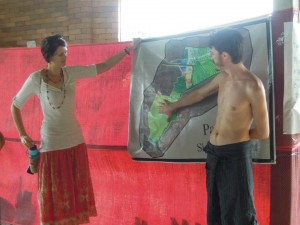 Finally, in the last few weeks leading up to the Permaculture Design Course, while still at Rak Tamachat in Thailand, I had the good fortune of being able to observe and participate in another Permaculture Design Course with John Champagne. During this course I had the opportunity to manage the course finances and administer the registrations and arrivals process. This allowed me a great insight into how to organize these systems for my own Permaculture Design Course.
Finally, in the last few weeks leading up to the Permaculture Design Course, while still at Rak Tamachat in Thailand, I had the good fortune of being able to observe and participate in another Permaculture Design Course with John Champagne. During this course I had the opportunity to manage the course finances and administer the registrations and arrivals process. This allowed me a great insight into how to organize these systems for my own Permaculture Design Course.
 Just after wrapping up the Permaculture Design Course, John facilitated a Teacher Training course. This was my second Teacher Training and it came just a few short weeks before I would be back in Austin, Texas teaching. This proved a great opportunity to refine my course outline and notes and fill in some blanks on how I wanted to approach each particular subject. Another great opportunity to apply my lessons from previous courses and test my development as a facilitator.
Just after wrapping up the Permaculture Design Course, John facilitated a Teacher Training course. This was my second Teacher Training and it came just a few short weeks before I would be back in Austin, Texas teaching. This proved a great opportunity to refine my course outline and notes and fill in some blanks on how I wanted to approach each particular subject. Another great opportunity to apply my lessons from previous courses and test my development as a facilitator.
Food
The food system of a Permaculture Design Course is one of the most critical elements to get right. Food choices can make or break a course, as expectations of permaculture food systems tend to be very high. I was fortunate to have the good advice, guidance and enthusiasm of some amazing friends. Had it not been for the advice and hard work of these wonderful people, I have no doubts that what turned out to be a great success, would have otherwise resulted in an epic fail.
a crucial oversite
Initially, my plan was to leave the food up to course participants. When I took my Permaculture Design Course, no food was included. And, to keep course costs down and stay competitive with other courses in the area, I felt this was a wise decision. In reality, I had overlooked a very crucial detail: the design course I had taken was run over 8 weekends giving participants plenty of time between classes to prepare their meal for the next weekend. My course was to be a two week intensive with very little free time available for participants to prepare the next day’s meal.
This detail was reveled to me by Bright Sky. I was stunned. How could I have failed to recognize that? I had to act quickly to make some adjustments. I altered the course advertisements, course listing and booking processes to let people know food costs were not included in the price of the course.
Fortunately, my experience at Wheatsville Co-op and friends in the local farmers markets tied me into many generous vendors, farmers and artisans. I quickly called up the best cook I know, Addie Broussard. For the past two years she cooked local wholesome meals for a huge bunch of hungry children at El Ranchito summer camp.
Because of her own scheduling challenges, and a promotion at West Cave Preserve she was unable to facilitate the food for the course herself and instead took on a supporting role as the torch was passed to Beth Beutel. Beth had spent a great deal of time working with vendors and customers through Wheatsville and did an amazing job facilitating food for the course. She collaborated with tons of vendors to procure donations, sponsorships and, most permaculture of all, diversions of waste streams, to insure that all the course participants were well nourished and happy.
We were suggesting a donation of $10 a day for food provisions and we also promoted participants to bring local and homegrown foods in place of monetary donations. Through creative thinking and responding to feedback we turned what could have been a complete disaster into a great example of permaculture principles and ethics in action.
Miscellaneous Details
There are so many other miscellaneous details to designing a Permaculture Design Course. One piece that I will share with you all here is one that I feel captures many of those minor details in a single email. It is the final email sent out to course participants in preparation for the start of the course. As one of the final elements of the design, this email is a great piece to conclude the design portion of this project.



